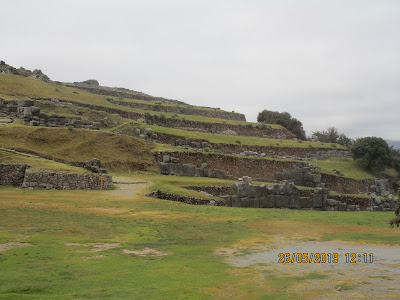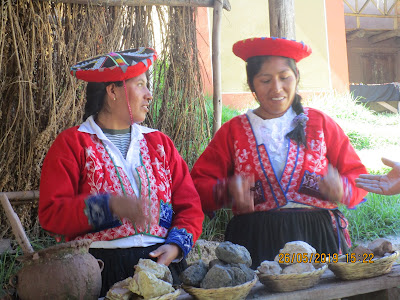Then we stopped at Sacsayhuaman (generally humorously pronounced Sexy Woman). This site is called the New World Stonehenge. Its name, a Quechua word, means "satisfied hawk". People refer to it as a temple but it was primarily a fortress. It runs for about 400 metres in length from the Sapi river on one side to the Tullumayo river on the other. With 2 rivers and Sacsayhuaman above Cusco was relatively safe from marauders. There are 3 tiers of walls in a zig zag shape and at the top of the hill the remains of 3 towers. The stones of Sacsayhuaman are massive, one weighing more than 200 tons. There is a theory that claims that all of Cusco was laid out to to form a puma shape so Sacsayhuaman is the head. Sacsayhuaman is still used today, mainly for reenactments of Inca ceremonies. If we had stayed until the 22nd of June we would have seen the celebration of Inti Raymi. And it would have been fantastic though my altitude sickness would probably have rendered me oblivious or at least uninterested in the whole thing. Noew that I am at home I really regret the amount I missed out on in Cusco.
The walls of Sacsayhuaman are amazing. How did the Incas, who had not invented the wheel or the lever and who had no draft animals, move such vast rocks? And add to this that they were laid in such a way that you couldn't even slide a piece of paper between them. A massive feat of engineering! Spaniards dismantled some of the stones to build their churches but what are left were too big for the Spanish to handle.
Our next stop was briefly at Puka Pukara. Puka Pukara is a military ruins site on the road to Pisac. Its name in Quechua means "red fortress" probably from the red colour of the rocks at dusk. We were very high up and it was very hazy.
Henry demonstrating that how women in Ccaccaccollo wear their hats indicates their marital status. Sarah and Charlotte obviously enjoying the demonstration.
Showing how the alpaca and llama fleece is washed with a natural root. It actually worked very well.
During this demonstration a lovely little girl, about 2 years old, kept coming in to the hut and being shooed away by the native women. Eventually she settled herself beside Ann who was very good with her.

I would have loved one of these hats but I hadn't the energy to browse. One of the women gave me a chair from where I sipped mint tea and observed.
Guinea pig - cute but for food!
They were planning a real feast for the festivasl!
And on we drove through the Sacred Valley admiring the mountains, river, cultivated fields and terraces.
Our next stop was at a place that did good empanadas. Jim and I shared a cheese one - delicious. Then the energetic, breath-ful members of the group set off uphill to a pottery place - Cuyo Chico pottery - to get demonstrations of the whole process. The breathless ones - Charlotte and I - were left in the bus to admire the countryside.
Henry looking forward to his empanada.
Cuyo Chico (another G Adventures project) seems to be similar to Ccaccaccollo only the emphasis here is clay with bricks being made for building adobe houses and pottery made from the clay.
They were going all the way up here!
The welcome committee.
Making bricks - a bit like traditional wine making with a lot of stamping.
An example of ceramic bulls that are bought to give as presents to bring luck. In the Cusco area and
around Pukara Torito de Pucara are placed on the roof to bring good fortune. The idea originated with the Incas who relied on images of alpacas which they called illas . The illas were used to protect their flocks and to ensure reproduction and also to protect their buildings. When the Spanish came bulls were substituted for alpacas and religious symbols, crosses and ladders, were placed along with the bulls.
An example of ceramic bulls that are bought to give as presents to bring luck. In the Cusco area and
around Pukara Torito de Pucara are placed on the roof to bring good fortune. The idea originated with the Incas who relied on images of alpacas which they called illas . The illas were used to protect their flocks and to ensure reproduction and also to protect their buildings. When the Spanish came bulls were substituted for alpacas and religious symbols, crosses and ladders, were placed along with the bulls.
Roasted guinea pig.
Here we were welcomed at the Parwa Community Restaurant, a G Adventures for Good project. The food here was excellent.
We started with 3 types of mini breads and herb butter which were lovely. Then we had a huge salad and corn things with salsa. Then stuffed peppers, mini potatoes and a chinese style fried quinoa. This was all great for Sarah who is a vegetarian.
Chicha Morada - a corn drink which did not look too appealing to me. I had lemonade which was very refreshing.
And for dessert strawberry jelly and mango cheesecake.
The restaurant is in a lovely setting.
Entertainment!
It had its own kitchen garden.
We continued on our way through the Sacred Valley along the Urubamba river to Ollantaytambo. It is a very beautiful journey.
Corn drying.
Our first views of Ollantaytambo. It is the best surviving example of Inca city planning with narrow cobbled streets that have been inhabited since the 13th century. Notice the irrigation channel.
The ruins of the old store houses built by the Incas. They were called qollqa (Colca).
We were staying in the Ollantaytambo Lodge which is in a beautiful setting. Lotte and I were taking advantage of the last of the evening's sun.
Jim and Sarah went off to explore the town. I was feeling a little better so thought I might do likewise but realised Jim had my purse in his man bag. I thought I would take a stroll but when I left the hotel I realised I was getting breathless again and, with my poor sense of direction, thought I would get lost. So back again to the hotel where I discovered I was locked out. Eventually I found the doorbell at just about the limit of my tiptoe stretch and I was let in by one of the girls who work there.
People climbing The Fortress or Temple Hill.
Jim took advantage of the market in Ollantaytambo to get a Peruvian blanket and a painting of llamas which didn't impress me much at the time but which are actually very nice.
Sarah, Jim and I went out to a cafe for a sandwich. I was not quite as breathless as I had been so that meant I felt a bit better. It was quite a hill back from the cafe so Jim andf I got a tuk tuk and Sarah walked back.
It was Anne's birthday the next day so we all signed a card for her. In bed by 8.30 pm in preparation for leaving at 7am next morning.



































































































































































No comments:
Post a Comment